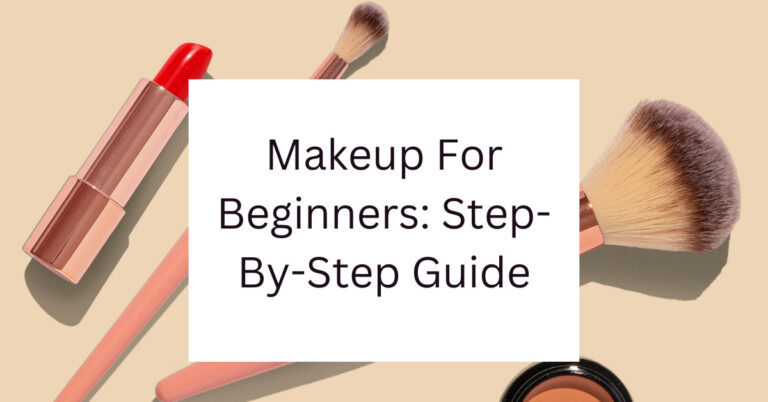
Embarking on your makeup journey can be both exhilarating and intimidating. The vast array of products, techniques, and trends might seem overwhelming, but with the right guidance, anyone can become adept at creating beautiful looks.
This article is designed as a comprehensive guide for beginners, providing a step-by-step approach to the basics of makeup application. Whether you aim for a natural daytime look or a glamorous evening style, mastering these fundamentals will serve as your foundation.
Makeup For Beginners: Step-By-Step Guide
Step 1: Skincare Preparation:
Before diving into makeup, it’s essential to prepare your skin. A well-hydrated and primed face not only ensures a smoother application but also enhances the durability of your makeup.
Start with a gentle cleanser suited to your skin type to remove impurities. Follow with a hydrating moisturizer, allowing it to fully absorb into your skin.
If you’ll be spending time outdoors, don’t forget to apply sunscreen to protect your skin from harmful UV rays.
Finally, use a primer that matches your skin type to create a flawless base for makeup application. Primers can also address specific concerns such as minimizing pores, controlling shine, or adding radiance.
Step 2: Foundation:
Foundation serves as the second skin that evens out your complexion and conceals minor imperfections. For beginners, it’s vital to choose the right shade and formula.
Test shades along your jawline to find the perfect match, and consider your skin type when selecting a formula (e.g., matte for oily skin, hydrating for dry skin).
Application technique plays a crucial role in achieving a natural finish. Start with a small amount of product and apply it to the center of your face, blending outward with a damp beauty sponge or foundation brush.
Build coverage gradually to avoid a cakey appearance. Remember, the goal is to enhance your natural skin, not mask it entirely.
Step 3: Concealer:
Concealer is your secret weapon for targeting specific concerns such as dark circles, blemishes, or redness.
Opt for a concealer one or two shades lighter than your foundation for under-eye application, which can help brighten the area. For spot concealing, choose a product that exactly matches your foundation.
Apply concealer using a small brush or your fingertips, dabbing the product gently onto the targeted areas. Blend seamlessly into the surrounding skin, ensuring there are no noticeable lines of demarcation.
Step 4: Setting Powder:
To ensure your foundation and concealer stay in place, apply a light dusting of setting powder. This step is especially crucial for those with oily skin, as it helps control shine and maintain a matte finish.
Use a fluffy brush to sweep a translucent or lightly tinted powder over areas prone to oiliness or where you’ve applied concealer.
Avoid applying too much powder, as this can create a heavy or aged appearance.
Step 5: Blush, Bronzer, and Highlighter:
Adding color and dimension to your face can truly bring your makeup look to life. Start with a blush, applying it to the apples of your cheeks for a natural, rosy glow.
For bronzer, use a large, fluffy brush to sweep the product lightly around the perimeter of your face, under your cheekbones, and along your jawline. This technique adds warmth and contour.
Highlighter should be applied to the high points of your face where light naturally hits, such as the tops of your cheekbones, the bridge of your nose, and the cupid’s bow. Use a light hand, as the goal is a subtle, luminous effect.
Step 6: Eyebrows:
Eyebrows frame the face and can dramatically impact your overall look. For beginners, it’s advisable to start with a pencil or powder that closely matches your natural brow color.
Use short, light strokes to fill in sparse areas, mimicking the natural hair.
Brush through with a spoolie to blend the product and create a more natural appearance. As you become more confident, you may explore gels and pomades for added definition and hold.
Step 7: Eyeshadow:
Eyeshadow can be as simple or as complex as you desire. For everyday looks, stick to neutral shades that complement your eye color.
Begin with a base color (close to your skin tone) applied all over the eyelid to even out discoloration.
Then, use a slightly darker shade in the crease to add depth and definition. For a touch of brightness, apply a light, shimmery shade to the center of the lid and the inner corner of the eye. Remember to blend thoroughly to avoid harsh lines.
Step 8: Eyeliner and Mascara:
Eyeliner defines your eyes and can be applied on the top lid, the bottom lash line, or both. For a natural look, opt for a brown or black pencil liner, and keep the line as close to your lash line as possible.
Mascara is the final touch to open up your eyes. Wiggle the wand at the base of your lashes and sweep up to add volume and length.
Step 9: Lips:
Start with a lip balm to moisturize your lips. Line your lips with a lip liner that matches your lipstick to define their shape and prevent the color from bleeding.
Fill in with a lipstick or gloss of your choice. For a more precise application, use a lip brush.
Final Thoughts
Remember, makeup is an art form and a means of self-expression. There are no hard and fast rules – feel free to experiment and discover what works best for you. Practice makes perfect, so don’t be discouraged if your first few attempts aren’t flawless.
F.A.Q
What do I need for makeup for beginners?
For beginners, you typically need the following basic makeup items: foundation or BB cream, concealer, powder, blush, neutral eyeshadow palette, mascara, eyeliner, and a lip color (lipstick or lip gloss). Optional additions can include a brow pencil, eyelash curler, and primer.
What makeup should I start with first?
Start with a basic makeup routine: moisturizer, foundation or BB cream, mascara, and lip balm or gloss.
How do I choose a foundation color?
Choose a foundation color by matching it to your jawline in natural light, considering your skin’s undertone (warm, cool, or neutral), and testing samples before purchasing.
Do I need a concealer?
It depends on your skin concerns. If you have dark circles, blemishes, or discoloration you wish to cover, concealer can be useful.
About me

Sham
AuthorHi, Sham here! I just wanted to share some fun topics on this blog. Thanks for stopping by. I hope you'll stick around.
